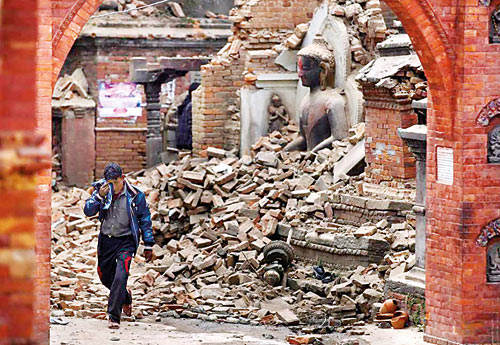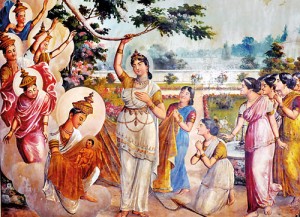A 2500-year-old message of compassion and love
As the country prepared to celebrate Vesak, we received the shattering news that Nepal, the Buddha’s country has been devastated by a massive earthquake which caused the loss of over 5,000 lives. Homes and historic sites in the land of the Buddha have also been destroyed.
This year, the full-moon Poya falls today, May 3 and Buddhists the world over will celebrate the Thrice Blessed Day of Vesak, the Birth, Enlightenment and Parinibbhana of the Sakyamuni Gautama Buddha.

A man cries as he walks past a damaged statue of Lord Buddha surrounded by debris from a collapsed temple in the UNESCO World Heritage Site of Bhaktapur on April 26, in Bhaktapur, Nepal. Such World Heritage Sites are a major part of Nepal’s tourism industry, which will take a major hit as a result of the earthquake (Reuters)
Kapilawasthu or Kapilavatthu on the Nepalese border, the capital of the kingdom of the Sakyans was where the young Prince Siddhartha Gautama lived until he gave up his worldly life in search of truth and Enlightenment.
Kshatriya King Suddhodana was the ruler of Kapilawasthu. His Queen Mahamaya, a princess of the Koliyas, on her way to her parental home stepped into the Lumbini Sal Grove where the sweet scented Sal flowers were in bloom. It was under the shade of a Sal tree that the Queen gave birth. The King’s happiness knew no bounds. Named Siddhartha Gautama, the prince lived in the lap of luxury. At his birth, it was predicted by the wise men, seven Brahmins, that if he remained to rule he would become a universal monarch, a cakravarti but if he renounced the world, he would become a Supremely Enlightened One. But Kondanna, the youngest and the wisest, said that he would definitely go in search of truth and become a Supremely Enlightened Buddha. The King was not happy to learn of this prediction, as he wished his son to inherit his kingdom and rule as a cakravarti. At the young age of sixteen, the Prince was married to his beautiful cousin Princess Yasodhara.
The worried King Suddhodana built three palaces for the prince to spend the three seasons in India. Living in the lap of luxury with music, song and dance, food and laughter, the Prince did not know of any sorrow; an illusion that was created to keep the Prince tied to the material world. But the father’s endeavours to keep his son attached to worldly pleasures was futile.
The turning point for the deep thinking, contemplative Prince was the four visions he encountered during his visits to the city. On the first occasion, when he was on his way to the royal gardens he saw a man very old and feeble. Next, he saw a sick man with sores on his body. On the third occasion he saw some men carrying a dead body on a plank. He looked at Channa his charioteer in surprise who explained to the Prince

A painting at Isipathanaramaya in Colombo depicting the birth of Prince Siddhartha
that everyone born to this life ages, will be subject to disease and finally die. On the fourth occasion, the Prince saw a calm and serene figure of a recluse. The Prince was impressed and was in deep thought. On his way home, he received a message that his wife Yasodhara had given birth to a son. He uttered the words “it is a fetter, I have a bond.” He believed that this attachment would deter his search for the Truth.
At the age of 29, he renounced his worldly life to lead the life of an ascetic, a mendicant. He struggled for six long years without any results.Realising that self-mortification did not help him in his search, he gave up fasting and took normal meals and believed in the Middle Path. His search was directed inwards to his own mind. Regaining strength in body and mind, he sat in solitude under a Bo tree on the bank of Neranjara the river which flowed through Gaya (Buddhagaya) to meditate and resolved, “even though only my skin, sinews and bones remain and my blood and flesh dry up, I will not rise from this seat until I have attained full enlightenment.”
He concentrated on his ‘in and out breathing’ to gain mindfulness (anapana sati). His mind was cleared of impurities and at the age of 35, again on a full moon day in May, attained Supreme Enlightenment, to be the Buddha. For 45 long years he fulfilled his mission of teaching the dhamma and at the age of 80 passed away, the final parinibbhana, ending the life circle of birth and death, once again on a full moon poya day in May, in Kusinara, the kingdom of the Mallas.
With the spread of Buddhism, society changed. Buddha categorised the people as Bhikkshu, Bhikshuni, Upasaka, Upasika and not according to caste or creed. Due to the spread of Buddhism, the culture, architecture and rituals influenced the life-style of the people in countries around the world.
Today Buddhism is alive as it was over 2,500 years ago. We should venerate the Buddha on Vesak day by remembering His message of compassion and universal love to all beings and not only by way of material worship. In their hour of need, as a meritorious deed, we should think of sending all that we would spend on Vesak ‘dansalas’ to the people of Nepal who are suffering today with the loss of their loved ones and homes.


